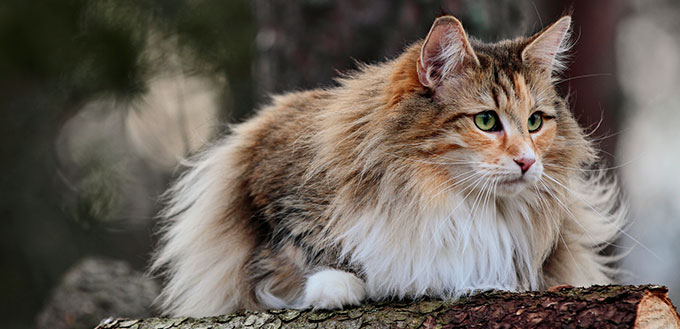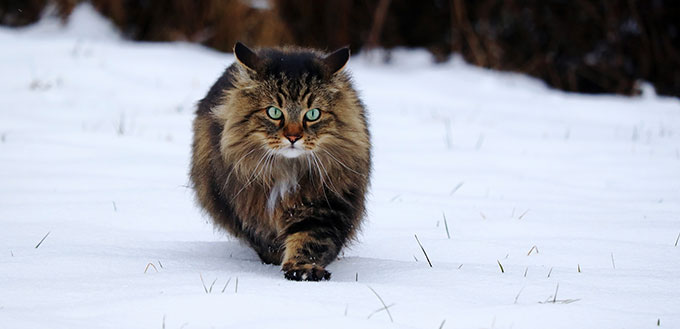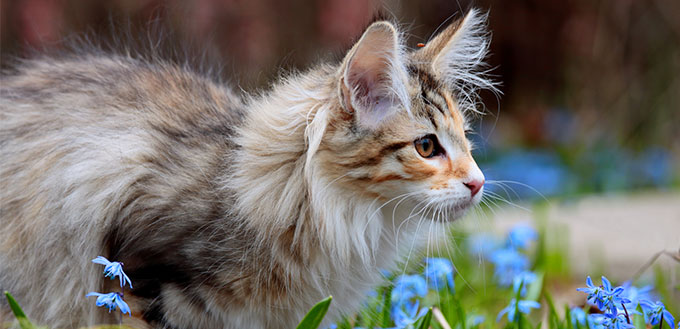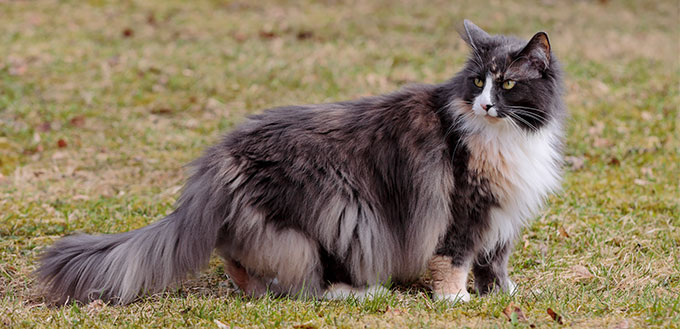Many people are attracted to Norwegian Forest Cats for their ultra-fluffy appearance, making you want to pick them up for a cuddle all the time! However, if you are thinking of adopting one of these cats, you need to make sure that you are entirely prepared. Though they take up to five years to reach their full size, once they get there, they are significantly bigger than other house cats. Forest Cats love to play and are known for their adept climbing abilities. And while they still love to retain their independence, they also enjoy socializing with humans too.
So, we have created this guide to offer plenty more information about Norwegian Forest Cats including some handy tips if you would like to bring one home yourself.

History of the Norwegian Forest Cat
Known as the Skogkatt in Norway, the Norwegian Forest Cat didn’t originate in the Scandinavian nation, but are thought to have come from local cats breeding with kitties brought there by Turkish traders. They were useful for their hunting skills and may even have kept mice off Viking ships! Their long and water-resistant coat developed to withstand the harsh Norwegian winters.
It wasn’t until the 1930s that this cat was recognized as a distinct breed. The Second World War nearly wiped out the breed, but they survived, and conservation efforts officially began during the 1970s. Known affectionately as Wegies, the breed arrived in the United States in the 1980s. CFA Championship status was obtained in 1993.
Quick Facts About the Norwegian Forest Cat
Norwegian Forest Cats are bigger than most domesticated felines, weighing between 12 and 22 pounds and growing up to heights of 18 inches. It takes them around five years before they are fully grown! A few common colors include white, black, red, and tabby. As for life expectancy, this tends to range between 14 and 16 years.
Looking at their physical traits, they are muscular and well-balanced with a powerful appearance. Males tend to be larger than females. Another defining trait is their large eyes, which open widely and appear more expressive than other cats. Their tails are long and busy – usually equal to the body from the base of the tail to the base of the neck.
The cats are so beloved in their home nation of Norway that King Olaf V designated them the country’s national cat!
While they are not as popular in the US, they have plenty of fans in Europe – especially in Scandinavia and France.
A genetically similar species to the Norwegian Forest Cat (and one that looks pretty similar too) is the Maine Coon. You may struggle to tell the two apart, but one way of doing so is looking at their faces. While the Norwegian Forest cat has a triangle-shaped face, the Maine Coon has a head that is more wedge-shaped with high cheekbones.
If you let your Norwegian Forest Cat roam around outdoors, don’t be surprised to see them scaling up trees as they are well-known for their excellent climbing skills. You may even see them running headfirst to get back down again!

Things You Should Know
Now that you know a few quick facts about Norwegian Forest Cats, you also need to know more about how to take care of one properly. We are going to talk about several different topics in more detail. Each one should prove to be useful in caring for your new cat. Here we have a few pointers to help you out in your task, ensuring that you bring up a happy and healthy cat.
Health
The first thing that you should know more about Norwegian Forest Cats is their health. Since they are a natural breed, they don’t have the same kind of genetic health issues that are common in mixed breeds. However, there are one or two things to bear in mind. A heritable condition is Glycogen Storage Disease IV, which is often fatal in kittens. A cat DNA test can help to keep your kitten healthy as you will be able to identify whether or not there are any problems there.
Another hereditary condition is hip dysplasia, which is prevalent in larger cats and can affect their movement and ability to jump. There are a number of different ways of dealing with this issue including medication, surgery, or simple weight loss. You can have your cat x-rayed to determine whether or not this is likely to become an issue. If your cat is in pain, you may have to work harder to prevent them from overexerting themselves by jumping up onto furniture.
Another condition that can affect Norwegian Forest Cats is glycogen storage disease type IV, which causes a potentially harmful build-up of the complex sugar in the cells of their body. And then you have the issue that can affect all cats: obesity. Making sure that your cat eats the right amount of food and gets plenty of exercises is the best way of keeping this issue at bay. If you notice that your cat starts putting on weight, it is best to act quickly rather than delaying. It’s not easy to get them to lose weight once it is on, so don’t dither if you think that any changes need to be made to their diet and/or lifestyle.
Of course, the risk of health problems developing continue to increase as your cat gets older, so you need to keep an even closer eye on them for signs that something is wrong. If you notice a problem, it is best discussed with your vet. Either you set your mind at ease that nothing is wrong, or you can start treatment options earlier.
Feeding
Norwegian Forest Cats descend from ancestors who were hunters. As such, they should enjoy a diet that is rich in protein from meat, giving them the energy they need for their active lifestyles. Choose a high-quality brand that uses real meat rather than one that is too full of by-products. There are also brands out there that were specifically made for the breed. Look out for taurine, an essential amino acid that is important for your cat’s vision and heart health. Unlike dogs, cats were not meant to eat carbohydrates, so they don’t process them well. In terms of calorie consumption, Forest Cats will inevitably eat more due to their large size.
You should feed your cat two measured meals a day. Some owners prefer a free-feeding approach, but this can sometimes lead to obesity in felines. Providing structured meals turns feeding into an event rather than something that is standard. Thus, it can help to improve the bond between pet and owner.
While we are on the subject of feeding, you also need to ensure that there is plenty of fresh, clean water available. You should change this every day and give the bowl a wash too. Choose a place that is easy for your cat to access and avoid an area that is too close to their litter box and cats don’t like to eat and drink too close to where they go to the bathroom.
Related Post: Best Cat Water Fountains
You can also add a limited amount of treats to their diet. These can come in the form of cat treats that are already packaged and ‘human food’ as well. A few examples of acceptable food includes canned tuna, cooked eggs, chicken, and turkey.

Care
Of course, diet plays an integral role in ensuring that your Norwegian Forest Cat stays healthy. And we will get onto the subject of grooming in the next section. But there are plenty of other ways that you can properly care for your cat too. Cats sleep for so much of their lives that a soft and comfortable bed should be an essential purchase. If you notice that your cat likes a particular area, this is the perfect place to choose.
Related Posts: Best Cat Beds and Best Cat Window Perches
Like all cats, you need to provide your Norwegian Forest Cat with a place that they can work out their scratching energy. If you have a few of these around your home, this will help to stop your cat from tearing up your furniture. At first, it may take a bit of time before you and turn your cat’s attention to the post. Rather than tucking it away in the corner of the room, choose somewhere more central. And to make it even more attractive, you can try sprinkling on some catnip.
You May Also Like: Best Catnip
If your cat uses a litter box rather than going outside, you will need to scoop the box out once a day and change the litter around once a week. If you have multiple cats, you will need multiple litter trays as well. Fill the box to the right level rather than making it too deep. Around two inches should be enough.
Just like all cats, you need to take your Norwegian Forest Cat into the vet on a regular basis – once a year is ideal. During this time, your kitty should have a physical, get tested for diseases, and receive vaccinations as well. Many owners decide to have their cat spayed or neutered to prevent some health issues and behavioral problems such as aggression.
While Norwegian Forest Cats enjoy their independence, they are also very loving towards their human owners. However, you should remember to give your cat a bit of space from time to time. Often, they will make the first move when they are looking for affection – perhaps by climbing on your lap. This breed of cat is also known for its intelligence, so you could try letting them play with some stimulating puzzle toys.
Another way that you can stimulate your kitty is by letting them work out their hunting instincts by investing in some popular cat toys that exercise this such as fur mice, electronic toys, and wand toys. Not only this, but it is also a great way to strengthen the bond between the two of you. And who doesn’t want to be that little bit closer with their kitty cat?
Grooming
The trademark coat of your Norwegian Forest Cat won’t start to develop until your kitten is three months old – and it does not reach full maturity until your cat is two.
While the Norwegian Forest Cat has a double coat of long fur, they only need to be washed in certain circumstances. This tends to be an easier job than with most cats as their coat is water resistant. However, you should get into the habit of combing your cat on a weekly basis using a stainless-steel comb or something thicker. However, during the spring and winter months, you should comb through the coat two or three times every week. This will help to prevent hairballs from accumulating all over your home and means that your cat will swallow less hair when they are grooming themselves.
Related Post: Hairball Remedies for Cats
A commonly overlooked part of caring a cat is cleaning their teeth on a regular basis. If you don’t do this at least once a week, it is almost inevitable that they are going to suffer from some form of periodontal disease. While this may be challenging at first, it gets easier over time. It also helps if you start your cat off from a young age. You should also trim their nails once a week too. And the same goes that it is better to start doing this early if you can.
Related Posts: Best Cat Toothpaste and Best Cat Toothbrush
If you have an indoor cat who goes to the bathroom in a litter tray, you need to clean this out several times every week – ideally every day. You should also wipe the corners of your cat’s eyes around once a week to get rid of any discharge. Each time you do this, you should use a new, clean cloth. Otherwise, it is likely that cross-contamination will occur. You should also check their ears for redness or bad smells as these are possible signs of infection.
Temperament
Hearing the words ‘Forest’ and ‘Cat’ put together may instantly conjure up images of something feral. But they generally aren’t a huge amount of trouble and will only demand attention when they are feeling especially hungry! They fit well into a range of different families thanks to their sweet and friendly nature with adults, kids, and other animals. However, they may prove to be shy when they are around strangers.
Norwegian Forest Cats are natural-born climbers, so it is worth getting them a special cat tree to stop them from scaling your curtains or the back of your sofa! Their active and playful personality can continue for years after they are fully grown, but their energy levels are average in cat rankings.
Many people think that because of their double coat, they are only suitable as outdoor cats. In fact, many of them are perfectly happy acting as playful indoor kitties. However, they are not a ‘lap cat’ as they have a little more independence than this. When you show your cat some affection, they are likely to respond with purring and pressing their head against your body. Unlike other cats, they don’t tend to vocalize a huge amount.
If you have plenty of time to spend with your cat, you can try clicker training them or teaching them other tricks. This will help to keep your kitty mentally stimulated and out of trouble. There are plenty of great puzzle toys out there that provide treat rewards once they work out how to get inside. Some people have described them as ‘dog-like’ in the way that they behave. Also, they are likely to develop a fondness for a special toy that they will want to play with over and over again.

Final Thoughts
If you are looking for an independent and intelligent feline, the Norwegian Forest Cat may prove to be the ideal addition to your home. While they are well known for being close to their families, they don’t demand the same level of attention that other cats do.
These cats may look like they belong outdoors, but they can happily exist as indoor cats to protect them from cars and attacks by other animals. In terms of looking after, you don’t have to do a huge amount beyond combing their coat a couple of times a week, feeding them a high-quality diet, and showing them plenty of TLC.
When you are looking to adopt a Norwegian Forest kitten, you should choose a breeder who raises litters at home, handling them from an early age. Meeting one or both of the parents helps as you can get a better idea of whether or not your cat will have a nice temperament when they grow up. Since this is a more unusual breed of cat, it is less likely that you will find one in your local shelter, but there is no harm in looking as this is a great thing to do.
Check out our New Cat Cheat Sheet.
Sources:
-
- Norwegian Forest Cat, PetMD
- Norwegian Forest Cat, VCA Hospitals





